Bestiary
Raanan Beasts
Baneclaw
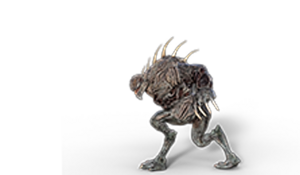
- Lifespan:
- Length:
- Weight:
- Native to Raana: yes
Baneclaws are ferocious bipedal predators indigenous to Raana, with charucks their only natural enemy. Thankfully only found alone or in pairs, they keep on growing as they age, reaching gargantuan sizes. Their dung is particularly effective as fertilizer. And given how dangerous they are, it is risky to obtain, and hence scarce, hence highly sought after, and valuable.
Beryll Monkeys
- Latin name: Inexor valacae
- Lifespan:
- Length:
- Weight: up to 200kg
- Native to Raana: Yes
Ape-like creatures native to the Irendorian continent. Lots of rumors circulate about these beings, many of them lurid, and some motivated by a desire to demonize them to justify exterminating them, as they live in forests which some humans would like to chop down for timber. More intelligent than the Earth gorillas that they equal in size: they are said to have language, live in villages, create and use tools, have some form of religion, and trade gemstones with humans. The rumors about their males' taste for human women, and the enormous size of their genitals, may also be true.
Thought to be most likely responsible for the "Beryll pottery culture", dated by its artifacts to the brief period 5,000-4,750 BHE.
Chanoga Wasp

- Lifespan: 3-5 years
- Length: 30-40 centimeters (12-15")
- Wingspan: 60-80 centimeters (25-30")
- Weight:
- Native to Raana: Yes
The chanoga wasp/chanugah hornet is one of Raana's few native flying creatures, dwelling mostly in regions of high altitude (3,000+ meters). It's extremely rare, thankfully, as its aggressiveness is a thing of legend.
Charuck
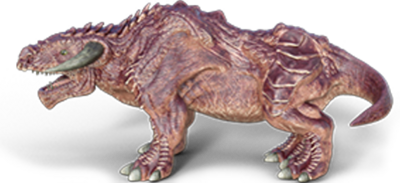
- Lifespan: 120-160 years
- Length: 12-35 meters+ (40-100+ feet)
- Weight: 6-30 tons or more
- Native to Raana: Yes
A "charuck" is a class of huge, reptile-like predator, as big as the largest of old-Earth's dinosaurs. The Academy has listed at least 20 different species, differing widely in size and appearance. Some are sea-dwelling but amphibious and can terrorize coastal villages; others stalk prey in dense jungles. They are seldom found in mountainous regions or open fields however. They are suspected to keep on growing with age, and so have uncertain upper size limits, since some truly monstrous examples have been alleged - though of course people exaggerate.
Devor Dragon
- Lifespan:
- Length:
- Weight:
- Native to Raana: Yes
A huge, dinosaur-like beast found in the Corazon jungles. As dangerous as a Charuck. Avoid.
Dukkas
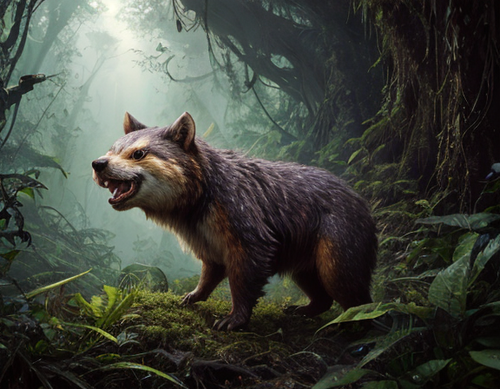
- Lifespan:
- Length:
- Weight:
- Native to Raana: Yes
A smallish Raanan game animal; a good source of pelts and meat. Dukkas are omnivores that live in burrows, in family groups of up to a dozen. Like badgers in some respects, but forage in packs. They aren't dangerous to humans.
Femmer beasts
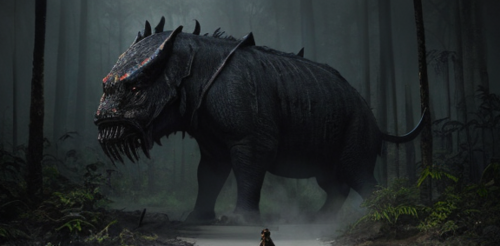
- Lifespan:
- Length:
- Weight:
- Native to Raana: Yes
A rare example of Raanan fauna which has proved amenable to human domestication. Adaptable omnivores, like Terran boar. Large, strong, and armed with defensive horns and a thick hide to resist the attacks of wrool cats and other medium-sized predators that they can't outrun. Their fearsome-looking mouth appendages are actually short, strong, jointed "tentacles" which they use for harvesting plant food and grubbing in the soil for tubers and worms. They are not aggressive towards farmers, who they recognize as a source of easy food. Kept on farms and raised for meat and thick leather.
Galdar
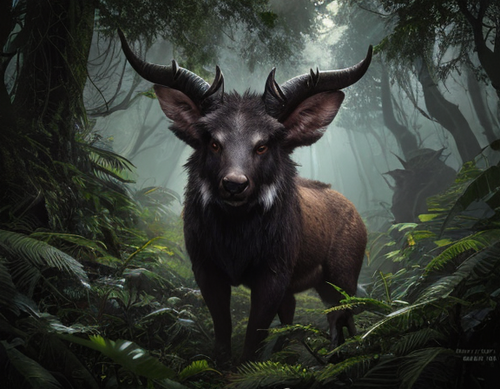
- Lifespan:
- Length:
- Weight:
- Native to Raana: Yes
Galdar are the Raanan equivalent of Earth deer. Hairy, hooved and horned herbivores, which can be heavier than a human, but tend to run away rather than fight. A useful source of hides and meat. Hunted in the forests, jungles and swamps outside the Great Biological Wipe.
Halodim
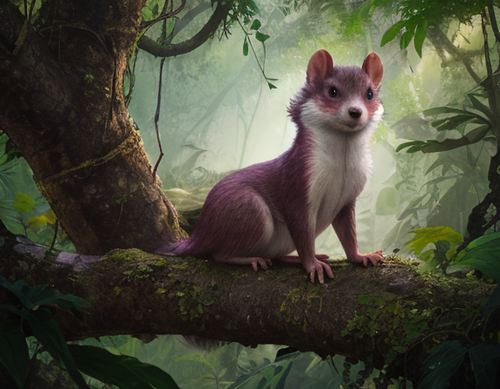
- Lifespan:
- Length:
- Weight:
- Native to Raana: Yes
Native, rodent-like animals found in the Corazon jungles. Similar to squirrels in some respects, but larger, and spending more of their time on the ground, where they hunt insects & grubs to supplement their fruit & nut diet. They move and forage in packs like monkeys. Harmless to humans; there's not much meat on them, but they are a good source of Pelts.
Lurkmite
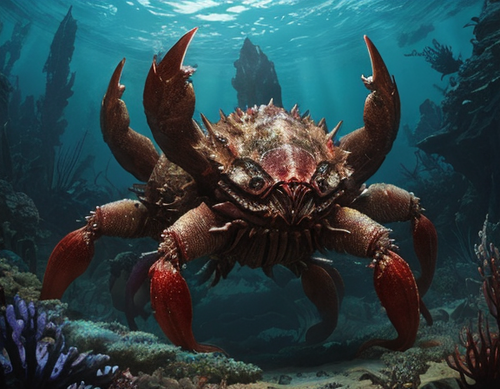
- Lifespan: dozens of years
- Length: 1m
- Weight: 20kg+
- Native to Raana: yes
Aquatic, crab-like arthropod the size of a dog. Hard-shelled and aggressive, they are ambush predators, with upward-pointing pincers used to grab and stab creatures swimming above. They also sometimes attack on land, lurking in the shallows to leap out at animals coming to the waterside to drink or forage. Hence they sometimes attack humans, and can cause serious injuries, though they won't stray far from water or stay out for long. Named after the arachnid mites from Earth that they resemble - though they are thousands of times bigger.
Reese skunks
- Lifespan: 3-6 years in the wild
- Length: 30-90cm
- Weight: 1-8kg
- Native to Raana: Yes
Native, skunk-like game animals found in the Corazon jungles. Harmless, except for the fact that they spray stinking fluid to deter predators (hence their name). Also like Earth skunks they are encountered singly or in small family groups, live in burrows, and forage for roots, tubers, worms and grubs. There's not much meat on them, but they are a good source of Pelts.
Tar snakes
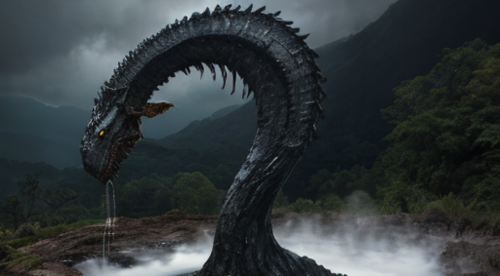
- Lifespan:
- Length: 100m+
- Weight: hundreds of tons?
- Native to Raana: yes
Gigantic, elongate, burrowing, reptile-like creatures, far bigger than any animal ever evolved on Earth. Named after the geological deposits they are typically found in, they seem able to thrive in tar lakes and tar sands which are toxic to most creatures. Their presence renders these fossil fuel resources, scarce already on Raana, almost inaccessible to humans.
Capable of standing up to even large bodies of soldiers equipped with the best weapons; their defenses seem not merely physical. One was recently responsible for a recent incident on the Haalu Plateau which dealt a severe blow to the Chancellor's elite space marine force. Stay well away.
"The Degosa tar pit is famous for the Haalu incident in September 2488, when 120 space marines were sent to destroy a large tar snake dubbed "The Degosa Demon". They failed miserably, and the 500-foot serpent pulled over 70 marines into the depths of its dark abode. Those who survived, came back... changed. Most subsequently rejected the call to go back into service even though refusal to guard the Spheremasters equals a death sentence once you have taken the space marine oath."
Wrool Cats
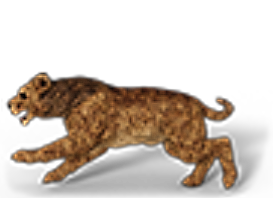
- Lifespan: 10-20 years
- Length: 1-2 m, plus tail
- Weight: up to 100kg
- Native to Raana: Yes
A cat-like, leopard-sized predator native to Raana. Widespread, fierce, and bold enough to enter cities.
Earth fauna out-competes Raanan fauna, but since the human colonists brought mostly herbivores rather than carnivores, wrool cats are managing to survive, preying on deer and boar in the absence of wolves and lions. A rare example of Raanan native life surviving in the Great Biological Wipe.
They hunt in small family packs, though adolescent males can be encountered on their own. Tough, aggressive, and dangerous, attempts to tame them haven't gone well so far. They seem quite intelligent; maybe that is why.
Raanan Pests
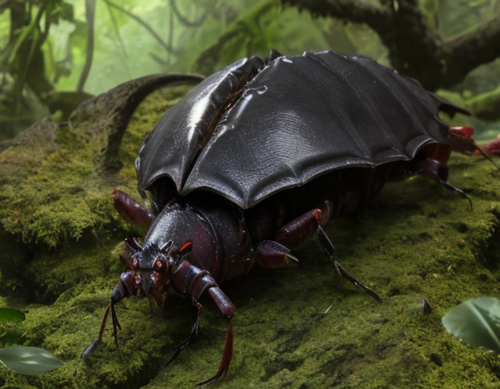
Bitter Bugs
- Lifespan: 2 years
- Length: 4-6cm, plus sting
- Weight:
- Native to Raana: yes
Small, insectoid, Raanan creatures that can survive inside the Great Biological Wipe and can be encountered when gardening or farm working. They are notorious for their venomous sting, which is extremely painful, and potentially lethal for infants or the old & frail. Reason to wear gloves when gardening!
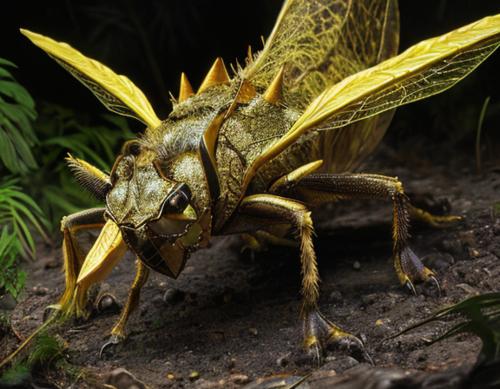
Cikko flies
- Lifespan: months
- Length: 10cm
- Weight:
- Native to Raana: yes
Locust-like creatures which reproduce very quickly when food is abundant, to form swarms that can devastate crops and stored food. They can survive well on a diet of the plant species imported from Earth, eating stems, leaves and fruit. They spend most of their lives in larval forms like caterpillars, which can reproduce asexually like aphids, budding out little versions of themselves. If food starts growing scarce they molt into a more complex adult form which has wings and can fly weakly, and lays batches of eggs rather than giving birth to individual live young.
Cikko flies' yellow coloration is a warning to potential predators that they are bad tasting and mildly toxic to eat.
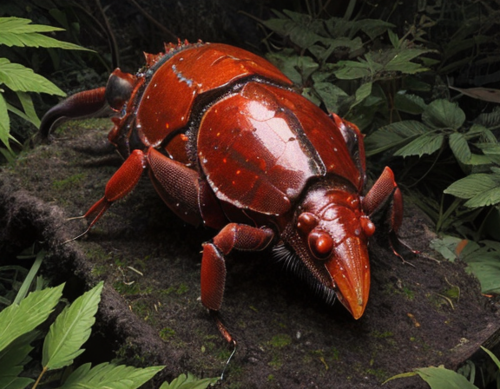
Dungah crawlers
- Lifespan: several years
- Length: 3mm to 10cm
- Weight:
- Native to Raana: yes
A beetle-like Raanan invertebrate, flightless and burrowing, which can survive well on a diet of the plant species introduced from Earth. They breed very quickly and can form plagues which devastate crops in fields (where they eat the roots) and also grains in storage if they make it into warehouses or food silos. They reach sexual maturity when still tiny but keep on growing bigger with age. Their eggs are just a millimeter across, and when small they can produce just one at a time, but as they grow bigger they can make more and more eggs, and the mouse-sized individuals are mobile egg factories, turning a large proportion of the food they eat into eggs and dropping a constant stream wherever they go.
Dungah crawlers are nutritionally poor, and if finding that they have infested your stored flour or rice, it is best not to view them as an added source of protein, because the faeces they deposit in the food, and the bacteria these contain, render it unfit for human consumption.
Narlet
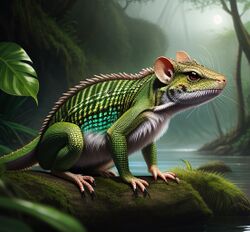
- Lifespan: 6-12 years.
- Length: 15-40 centimeters (10-15")
- Weight:
- Native to Raana: Yes
A narlet is a small rodent-like creature common in all of Irendoria. It's ragged fur and bony structure make the creature uninteresting for most hunters - only a handful of destitute tribalists are known to frequently hunt the animal
Rodar vermin
- Lifespan:
- Length:
- Weight:
- Native to Raana: yes
Raanan creatures that occasionally boom in numbers to form plagues which devastate human crops and food stores.
Vermer rats
- Lifespan:
- Length:
- Weight:
- Native to Raana: yes
Pests that occasionally boom in numbers to form plagues which devastate human crops and food stores.
Earth Invasives & Livestock
Boars
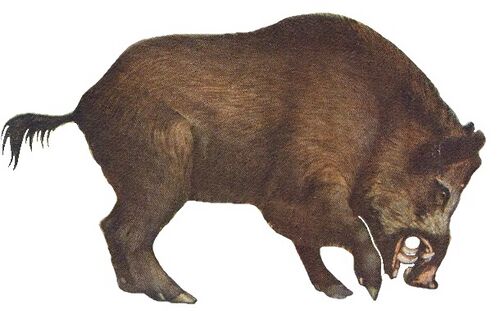
- Lifespan: 10-14 years
- Length: 1.5-1.8 m
- Weight: 60-200 kg
- Native to Raana: No
Introduced from Earth, and now plentiful in the wetlands within Ikaanos City and some other areas in and around human habitation (within the growing area of the Great Biological Wipe). These fierce omnivores can be hunted safely as long as you are better armed than they are, and keep an eye out for bandits. People concerned about the replacement of native Raanan flora & fauna with invasive Earth species encourage the culling of boar as pests.
Chickens
- Lifespan: 5-10 years
- Length: 25-70 cm
- Weight: 1-5 kg
- Native to Raana: No
Brought from Earth and surviving fine on Raana in farms, as a source of eggs, meat, and feathers for bedding. They can fend for themselves on farms, eating any small animal they find as well as seeds and some plant matter, but this active lifestyle make them eventually too tough for eating so just useful for the occasional egg. So they are kept indoors, provided with food and killed young if wanted for meat.
Deer
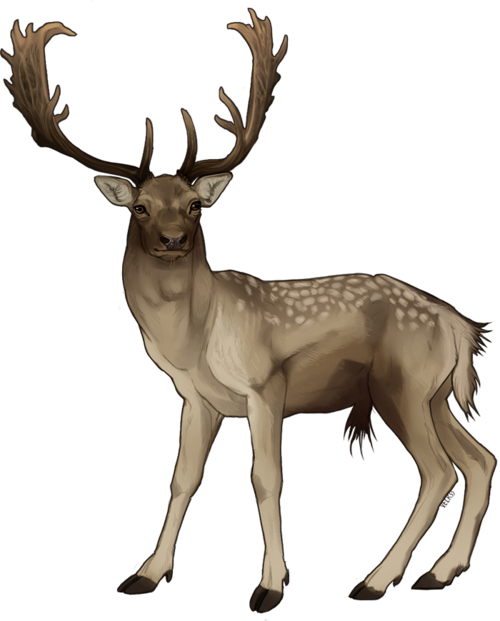
- Lifespan: 10-13 years
- Length: 2m
- Weight: 100-200 kg
- Native to Raana: No
Introduced from Earth, and now plentiful in undeveloped areas around Ikaanos and some other human settlements (within the growing area of the Great Biological Wipe). These gentle herbivores can be hunted safely as long as you keep an eye out for bandits. People concerned about the replacement of native Raanan flora & fauna with invasive Earth species encourage the culling of deer as pests.
Dogs
- Lifespan: 6-14 years
- Length: 25-100 cm
- Weight: 1-100 kg
- Native to Raana: No
Brought from Earth as companion animals, guard dogs, and some for work on farms. They come in a wild variety of shapes, sizes & colors.
Horses
- Lifespan: 25-50+ years
- Length: 2.4 m
- Weight: average 400-600 kg (absolute 26kg - 1,500kg)
- Native to Raana: No
Another Earth import, used in agriculture and for pulling carts as well as a self-fueling human transport. Well-suited to Ikaanos' unsurfaced, muddy tracks. You can enroll your slaves in one of Ikaanos' riding schools, or build a Stables in your Yard and buy your own horses. Depending on fitness, horses can comfortably carry a rider and saddle totaling 15-25% of their own body weight or less (e.g. a 500kg horse can be expected to carry a rider, saddle, rug, bridle, bags etc totaling 100kg).
Mules
- Lifespan: 35-50+ years
- Length: 2 m
- Weight: 300-700 kg
- Native to Raana: No
Another Earth import, these hardy, willful & characterful creatures rarely roam wild - they are used as beasts of burden, well-suited to Ikaanos' unsurfaced, muddy tracks. Doubly convenient, as they self-fuel by eating the familiar Earth plants of the great biological wipe rather than needing rare fossil fuels or scarce biofuels, irreplaceable Energy Cells, or a connection to a fusion power module. You will likely acquire a couple to haul camping equipment around if you want to explore beyond Ikaanos City itself; they come included in the price of a "Camp Level 2".
Cattle
- Lifespan: 25-30, but usually slaughtered after 5 years (dairy) or 18 months (beef).
- Length: 1.5-2.5 m
- Weight: 400-1,200 kg
- Native to Raana: No.
Another livestock species transported in from Earth in hopes it might be able to survive on Raana. Raised for use as beasts of burden as well as for their meat, milk and leather. Female cattle are called cows when mature and heifers when young. Male cattle raised for their meat are castrated to make them docile, and called steers. If uncastrated for use in breeding, male cattle are called bulls when mature and bullocks when young. Cattle used for pulling carts or ploughs, or even for riding, are usually male, usually castrated, and known as oxen; their laboring makes them big and strong but their meat becomes too tough for easy eating.
Raanan Flora
Denaar trees
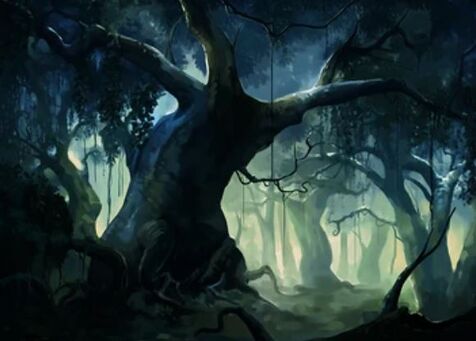
Famous for the addictive, destructive, mind-altering drug easily extracted from resin in its bark, which is currently reckoned to be ruining the lives of over 12% of Ikaanos' population. The Raana-native plant is common in the foothills of the Beryll mountains, brightening up the forests with its red flowers.
Dungah moss
A plant that's almost as much a threat to Ikaanos as the monstrous, jungle-roaming lizards outside the Great Biological Wipe which keeps most other Raanan species at bay. This fast-growing moss-like thing turns brick, mortar, concrete and soft rock into soil enough for it to grow on - fast destroying buildings in the process. Growing so fast that some of the poorest of the poor are employed as "dungah pickers" to control it, it is inedible to Earth fauna, but sometimes used as an ingredient in antibiotic paste.
Haal trees
A tall, long-lived, Raanan evergreen tree, one of the few able to survive in the Great Biological Wipe around human settlements. Haal wood is useful for furniture, wood paneling, and weapons manufacture, and has a pleasant aroma when freshly cut. Its sap is also a source of syrup, and useful oils can be extracted from the plant too.
Rembar vines
One of the few species of native flora able to survive in the Great Biological Wipe inadvertently introduced to Rana by humans. It's a fast growing plant that spreads over buildings, with roots that break masonry apart. Along with dungah moss, working to return human coloniser constructions back to the verdant chaos of Raanan nature.
Abominations
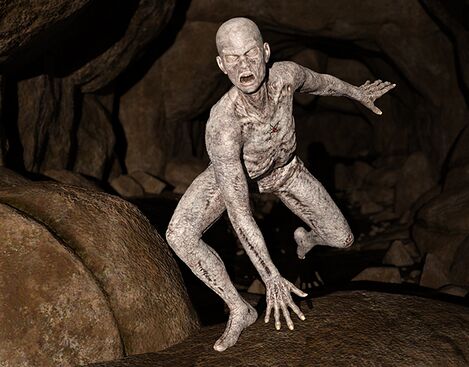
Rumors are spreading of things arising from the interaction of Raanan and Earth life beyond the bounds of what's normally considered "natural". For example, survivors of the Haalu incident seem behaviorally and physically altered - cold and pale, no longer speaking, disconnecting from their prior lives. Suspected to be maybe diseased or infected by something, plus assuredly having sustained psychological damage or even alteration from whatever it was that they experienced... They are unnerving to be around, with people worrying if whatever is wrong with them might be infectious. Though others worry it's even worse than that, calling them "Prowlers", and muttering about "zombies" and "aberrations".